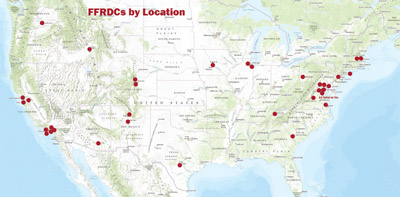
Federally Funded Research and Development Centers (FFRDCs) trace their origins to World War II, when new institutions were needed to address new challenges. The extraordinary science and engineering problems posed by the war called for a sustained R&D effort that combined independent and highly technical capabilities with the kind of long-term funding commitment that only the government could make.
Early precursors to today’s FFRDCs included the Applied Physics Laboratory at Johns Hopkins University, the Jet Propulsion Laboratory at the California Institute of Technology, and the Radiation Lab at MIT. These facilities offered first-rate R&D capabilities from the private sector underpinned by federal funding, the very essence of the FFRDCs.
As Sandia President and Labs Director Paul Hommert notes, the iconic predecessor and model for FFRDCs was Los Alamos Scientific Laboratory, where the nation invested substantial resources to develop the atomic weapons that ended World War II.
Paul recounts that Gen. Leslie Groves, who headed the Manhattan Project, initially envisioned Los Alamos as a pure government operation. Robert Oppenheimer, tapped by Groves to lead the Los Alamos lab for the project, convinced Groves that a more effective approach — and one more likely to succeed in drawing the top scientists and engineers that project demanded — would be to have an outside entity manage the lab, backed by government investment. Groves agreed and the results validated the approach.
The successes of Los Alamos and the other wartime labs offered a compelling model for FFRDCs, a structure that was formalized in the post-war era with the establishment of the RAND Corporation and several Atomic Energy Commission laboratories, including Sandia. Today there are 41 FFRDCs sponsored by agencies from across the government.
Shared characteristics
From the very beginning, FFRDCs shared several characteristics. The official FFRDC regulation states that FFRDCs:
- Meet special long-term national R&D needs of considerable complexity that cannot be met as effectively by in-house government or contractor resources;
- Have access to information beyond what is common to the normal contractual relationship;
- Cannot use special access to compete with the private sector;
- Are operated as autonomous organizations or by an identifiable separate operating unit of a parent organization;
- Are required to operate in the public interest, free from organizational conflict of interest;
- Anticipate a long-term relationships with the government;
- Provide the continuity that will attract high- quality personnel;
- Maintain currency in field(s) of expertise;
- Maintain objectivity and independence;
- Preserve familiarity with the needs of its sponsor(s);
- Provide a quick response capability.
Paul notes another key characteristic of FFRDCs: “I think it’s important to address the issue of independence. The government in effect says, ‘We’ve set you up and you’re supposed to be a technical, honest broker. We want you to give us your independent technical view, not colored by commercial or political considerations.’”
The issue of independence, Paul adds, is well-served by a model associated with the Department of Energy’s FFRDCs: They all operate under the government-owned/contractor operated (GOCO) model; the government owns the facility but it is managed by an outside entity from industry and/or academia. Sandia National Laboratories, for example, is an FFRDC. It is also a GOCO facility managed by Sandia Corporation, a wholly owned subsidiary of Lockheed Martin, for DOE/NNSA, the sponsoring federal agency. Sandians are not federal employees or employees of Lockheed Martin; all Sandians, including executive leadership, are employees of Sandia Corporation.
Div. 6000 VP Jill Hruby, who heads Sandia’s International, Homeland, and Nuclear Security Program Management Unit, and acting HR and Communications Div. 3000 VP Becky Krauss recently co-championed a key FY14 milestone related to Sandia Strategic Objective No. 3: “Lead the Complex as a model 21st century government-owned- contractor-operated national laboratory.” Specifically, the milestone was: “Develop specific recommendations to advance the FFRDC governance model with NNSA.”
While DOE operates all its FFRDCs as GOCOs, some other federal agencies operate FFRDCs as COCOs (contractor owned/contractor operated) and there are also government owned and operated research entities.
Becky sees value in having several management models among the nation’s research facilities. “I think the government needs that blend of government owned/government operated, contractor owned/contractor operated, and government owned/contractor operated laboratories. We bring different expertise and different cultures to the challenges that face the nation. As a result, the government gets the benefit of diverse perspectives. It’s a blending that benefits the government and national security as a whole.”
A brilliant construction
Regarding the GOCO/FFRDC model, Jill says, “The construct is actually in my opinion rather brilliant, in that you can have institutions that do government work with the best practices of the private sector.”
The FFRDC model is about more than just efficiency, Jill says. She sees in that model an expression of the very nature of our society.
“It says something fundamental about our country,” Jill adds. “It says something about democracy, about freedom, that the nation wants this vital work done outside the government with objectivity and independence.”
Beyond all the legal and definitional issues that describe FFRDCs, it is the importance and urgency of the mission and the service to the nation that resonates deeply at Sandia, Paul says.
“I think it’s a great privilege to be part of an FFRDC,” Paul says, “to be contributing in a laboratory that the government has said with some formalism is important to the nation, not just today, but tomorrow as well. The government has said ‘We’re not asking you to do something trivial; we’re asking you to do something challenging, something that maybe has never been done before, and we need your talent to take on that challenge.’”
“Not everybody’s going to spend their career working at an FFRDC,” Paul says, “but I really can’t think of a more rewarding place to be. The country’s going to throw problems our way — they’re going to be hard, and that’s exciting, it’s important. And it’s all done with a backdrop of public service.”